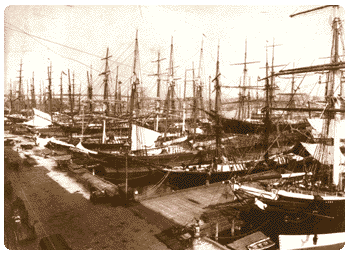Whether ascendant or in decline, New York has historically been a leader in trends affecting
the nation and the world, from manufacturing and strong unions to shopping malls,
suburbanization, and controlled-access highways -- even the public transportation systems
that originally allowed people to move out. What cities are really becoming at the end of the
millennium are centers of entertainment, culture, and command-and-control functions. In this
respect, New York is both exceptional and exemplary; what others will see elsewhere often
appears here first. For most of human history, cities have been places less of
manufacture than of exchange. In 1954, New York had more than 1 million manufacturing
jobs and was the world's leading industrial center, in terms of value added by manufacturing.
Those jobs have hemorrhaged in the past half century; the city now has fewer than 200,000.
Fifty years ago, New York was also the leading port in the world, with tens of thousands of
workers unloading and loading ships.  Few of those jobs are left, and they are mostly in New
Jersey. Containerization, de-unionization, and the rise of the ports of Long Beach (Calif.),
New Orleans, Houston, Baltimore, and Seattle have eroded New York's once-dominant
position.
Few of those jobs are left, and they are mostly in New
Jersey. Containerization, de-unionization, and the rise of the ports of Long Beach (Calif.),
New Orleans, Houston, Baltimore, and Seattle have eroded New York's once-dominant
position.
Yet New York has experienced job losses in the past and still managed to
recover. In 1868, Singer Sewing Machine moved to Elizabeth, N.J.; in the 1880s, Steinway
Piano moved from Manhattan to Queens; in the 1950s, General Foods and IBM moved to
Westchester. Manufacturing in cities actually turns out to have been a phenomenon that
lasted only about a century. Other American cities are now experiencing the agonies of losing
good-paying industrial jobs; what New York has done more effectively than many other cities
is to replace them with other jobs, mostly in the service sector. All you have to do to notice
the demographic change of the last quarter-century is ride in a taxi or go to a newsstand,
coffee shop, or greengrocer. Each of those businesses has been, in a sense, taken over by a
particular ethnic group. Immigrants have revitalized New York.
New York's
heterogeneity has been distinctive from other cities since its founding in the 1620s. The
Dutch established New Amsterdam not for religious freedom, not to provide a safety valve for
unhappy Dutchmen, but as a place to make money. This economic focus has an unattractive
side -- incredible discrepancies between the rich and the poor -- but its positive side is a
tolerance of newcomers. The bottom line in New York has always been a dollar sign; this
diminishes attention to ethnicity. The stock market, for example, has been a major escalator
for ethnic groups. New York was multicultural long before that term gained notoriety in the
20th century.
The typical model of an American city is a donut, with little in the
center except a few office buildings that are empty on weekends and evenings, and with
activity concentrated on the fringes of the metropolitan area in malls and corporate office
parks. In contrast, the center remains dominant in New York City. The development of Silicon Alley in lower Manhattan; the stunning
performance of the stock market; the turnaround in real estate; the rebuilding of the South
Bronx and large parts of Brooklyn; and the drop in crime -- which makes New York, according
to criteria that are hard to fudge (e.g., homicide and automobile theft), now the safest major
city in the United States -- all these factors are encouraging young Americans to rediscover
this city.
The current generation of college students essentially grew up in
shopping malls and realizes better than the rest of us how boring such places are. If you've
been in one or two, you've been in them all. Meanwhile, there is something distinctive about a
city street with lively sidewalks. People are coming back to New York, Boston, San Francisco,
Georgetown, and Baltimore precisely because they lack the blandness and retail uniformity of
the suburbs. Surely our civilization would be diminished if everyone went to a shopping
center and bought all their clothes from the Gap. And even though Manhattan now has more
Gaps and Banana Republics per square mile than anywhere else on the planet, no one could
ever mistake Broadway for a shopping mall.
Americans have historically associated
high density with danger, helped in no small measure by Hollywood movies and television
news. But in fact the reverse is true. New York is safer than other cities not because of the
homicide rate but because Gotham's automobile death rate is the lowest in the United States.
What a crowded environment does do is increase the happy things of life: the social diversity,
the numbers of potential partners you can meet, the variety of movies, plays, concerts, and
restaurants.
Renewed interest in cities may also be driven by ecologic concerns.
When we think of environmental responsibility, we tend to think of those living close to
nature in a rural, semi-rural, or suburban setting, but in fact the most "environmentally
correct" Americans are Manhattanites, because they use less energy than other Americans.
They use public transportation or walk rather than drive. They live in smaller apartments that
have warm walls, ceilings, or floors adjacent to other apartments, so those walls don't have to
be heated. (A single-family detached house gets the cold from six directions and costs much
more to heat.) By virtue of a high-density lifestyle, New Yorkers tread most lightly on the
land, which in spite of well-publicized garbage and pollution problems is exactly the reverse of
public perception.
The research community's contributions
Universities make an important impact on cities, not only through the billions they spend or
the people they train and employ, but also by studying and publicizing urban issues. For
example, Charles Abrams, who taught urban planning in
Columbia's architecture school, was the first person to blow the whistle on the federal
government's systematic discrimination against city residents by devaluing urban-pattern
neighborhoods in issuing mortgages. There is a longstanding American bias against cities; we
subsidize things that benefit the middle class, like home ownership and suburban roads, and
do much less for urban schools and infrastructure. Scholars can point out the ways cities could
thrive if the playing field were more level, as it is in so many other cultures.
Potential areas for research include the impact of immigration; the question of safety (is Jane
Jacobs right about "eyes on the street," suggesting that a higher-density environment is
safer?); the study of creativity and of the tendency of cities to be the natural habitat for the
unusual people who make major changes to civilization; the history of public administration --
especially public housing, which is a great success in New York, contrary to the images of
projects elsewhere being abandoned or blown up; and the problems of the infrastructure, both
the engineering challenges and the political challenge of maintaining facilities despite resource
limits. Cities, by definition, require us to depend on each other; they require clean streets,
functioning schools, and responsive fire departments, and paying for these things (especially
in a political system skewed against taxation) requires the creative, intelligent solutions that
research can provide. The articles in this Special Section call attention to some of the many
ways Columbia engages its community, becoming part of the tumble and tide of New York
life.
As William Faulkner
said, "The past isn't dead, it isn't even past yet." The hand of the past imposes limits on the
future -- especially in New York, where centuries-old decisions about where to build subways
or bridges shape the decisions we can make today. This year, for the first time in the history of
the planet, more people will live in cities than outside them. As our naturally social species
increasingly congregates in urban habitats, this movement offers historians and other scholars
ample opportunities both to predict, and possibly help shape, our future.
Related links...
The Urban Institute
The Sprawl Net, Rice
University's site devoted to urban sprawl
Megacities 2000 Foundation,
Netherlands
NYC documents,
Columbia Libraries
Center on Urban and
Metropolitan Policy
UpperWestSideCam (TM)
Special report on
New York's renaissance, John Marks, U.S. News, Sept. 29, 1997
Urban Morphology Research
Group, University of Birmingham, UK
Virtual Cities
Repository
KENNETH T. JACKSON,
Ph.D., is Jacques Barzun Professor of History and the Social Sciences. Among
his books are Crabgrass Frontier: The Suburbanization of the United States;
Cities in American History (with Stanley K. Schultz); the 30-volume
Columbia History of Urban Life (as general editor); and The
Encyclopedia of New York City (as editor-in-chief). His courses on urban history have
been among the most popular at Columbia for decades.
Photo Credits:
Medalion Animation: Photo: Howard R. Roberts/Special Effects: Howard R. Roberts and Graham Roberts/Animation The Gryphon Group
Port Photo: Collection of the New York Historical Society





 no regular police or firemen, no water system, no garbage pickup,
and no public transportation. Although it was on an impressive harbor, it was not an
impressive city.
no regular police or firemen, no water system, no garbage pickup,
and no public transportation. Although it was on an impressive harbor, it was not an
impressive city. Few of those jobs are left, and they are mostly in New
Jersey. Containerization, de-unionization, and the rise of the ports of Long Beach (Calif.),
New Orleans, Houston, Baltimore, and Seattle have eroded New York's once-dominant
position.
Few of those jobs are left, and they are mostly in New
Jersey. Containerization, de-unionization, and the rise of the ports of Long Beach (Calif.),
New Orleans, Houston, Baltimore, and Seattle have eroded New York's once-dominant
position.








